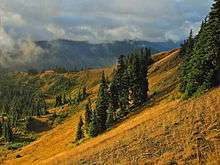Abies lasiocarpa
| Subalpine fir | |
|---|---|
| | |
| Subalpine fir, North Cascades National Park | |
| Scientific classification | |
| Kingdom: | Plantae |
| Division: | Pinophyta |
| Class: | Pinopsida |
| Order: | Pinales |
| Family: | Pinaceae |
| Genus: | Abies |
| Species: | A. lasiocarpa |
| Binomial name | |
| Abies lasiocarpa (Hooker) Nuttall | |
 | |
| Natural range of Abies lasiocarpa | |
Abies lasiocarpa, commonly called the subalpine fir or Rocky Mountain fir, is a western North American fir tree.
Distribution
Abies lasiocarpa is native to the mountains of Yukon, British Columbia and western Alberta in Western Canada; and to southeastern Alaska, Washington, Oregon, Idaho, western Montana, Wyoming, Utah, Colorado, New Mexico, Arizona, northeastern Nevada, and the Trinity Alps of the Klamath Mountains in northwestern California in the Western United States.
It occurs at high altitudes, from 300–900 metres (980–2,950 ft) in the north of the range (rarely down to sea level in the far north), to 2,400–3,650 metres (7,870–11,980 ft) in the south of the range; it is commonly found at and immediately below the tree line.
 Subalpine fir in Olympic National Park in mid-September |
 Subalpine fir in Mount Rainier National Park in late September |
It is a medium-sized tree growing to 20 metres (66 ft) tall, exceptionally to 40–50 metres (130–160 ft) tall, with a trunk up to 1 metre (3.3 ft) across, and a very narrow conic crown. The bark on young trees is smooth, gray, and with resin blisters, becoming rough and fissured or scaly on old trees. The leaves are flat and needle-like, 1.5–3 cm (5⁄8–1 1⁄8 in) long, glaucous green above with a broad stripe of stomata, and two blue-white stomatal bands below; the fresh leaf scars are reddish. They are arranged spirally on the shoot, but with the leaf bases twisted to be arranged to the sides of and above the shoot, with few or none below the shoot. The cones are erect, 6–12 cm (2 1⁄4–4 3⁄4 in) long, dark blackish-purple with fine yellow-brown pubescence, ripening brown and disintegrating to release the winged seeds in early fall.
Taxonomy
There are two to three taxa in subalpine fir, treated very differently by different authors:
- The Coast Range subalpine fir Abies lasiocarpa in the narrow sense, is the typical form of the species, occurring in the Pacific Coast Ranges, the Olympic Mountains and the Cascade Range from southeast Alaska (Panhandle mountains) south to California.
- The Rocky Mountains subalpine fir is very closely related and of disputed status, being variously treated as a distinct species Abies bifolia, as a variety of Coast Range subalpine fir Abies lasiocarpa var. bifolia, or not distinguished from typical A. lasiocarpa at all. It occurs in the Rocky Mountains from southeast Alaska (eastern Alaska Range) south to Colorado. It differs primarily in resin composition, and in the fresh leaf scars being yellow-brown, not reddish. The Flora of North America treats it as a distinct species (see external links, below); the USDA includes it within A. lasiocarpa without distinction.
- The corkbark fir Abies lasiocarpa var. arizonica occurs in Arizona and New Mexico. It differs in thicker, corky bark and more strongly glaucous foliage. In resin composition it is closer to A. bifolia than to typical A. lasiocarpa, though the combination "Abies bifolia var. arizonica" has not been formally published. The Flora of North America includes it within A. bifolia without distinction; the USDA treats it as a distinct variety of A. lasiocarpa. The cultivar 'Compacta' has gained the Royal Horticultural Society's Award of Garden Merit.[2]
Uses
The wood is used for general structural purposes and paper manufacture. It is also a popular Christmas tree. Corkbark fir is a popular ornamental tree, grown for its strongly glaucous-blue foliage.
Some Plateau Indian tribes drank or washed in a subalpine fir boil for purification or to make their hair grow.[3]
Gallery
-

Subalpine fir bark
-
_southwest_of_Jarbidge%2C_Nevada.jpg)
Close-up of foliage
-
_near_Bear_Creek_Meadows_southwest_of_Jarbidge%2C_Nevada.jpg)
Subalpine fir grove in the Jarbidge Mountains, Nevada
-
Young subalpine fir in alpine meadow along Sunrise road in Mount Rainier National Park.
-
Subalpine fir in Mount Rainier National park along Stevens Canyon Road.
-
Subalpine fir mixed with mountain hemlock along cow heaven trail in Mount Baker-Snoqualmie National Forest.
References
- ↑ Farjon, A. (2013). "Abies lasiocarpa". IUCN Red List of Threatened Species. Version 2013.2. International Union for Conservation of Nature. Retrieved 3 May 2014.
- ↑ RHS Plant Selector Abies lasiocarpa var. arizonica 'Compacta' Hornibr. AGM / RHS Gardening
- ↑ Hunn, Eugene S. (1990). Nch'i-Wana, "The Big River": Mid-Columbia Indians and Their Land. University of Washington Press. p. 351. ISBN 0-295-97119-3.
Further reading
- Conifer Specialist Group (1998). "Abies lasiocarpa". IUCN Red List of Threatened Species. Version 2006. International Union for Conservation of Nature. Retrieved 12 May 2006.
- Alexander, Robert R.; Shearer, Raymond C.; Shepperd, Wayne D. (1990). "Abies lasiocarpa". In Burns, Russell M.; Honkala, Barbara H. Conifers. Silvics of North America. Washington, D.C.: United States Forest Service (USFS), United States Department of Agriculture (USDA). 1 – via Northeastern Area State and Private Forestry (www.na.fs.fed.us).
External links
| Wikimedia Commons has media related to Abies lasiocarpa (subalpine fir). |
- Gymnosperm Database: Abies lasiocarpa
- Flora of North America: Abies lasiocarpa
- Flora of North America: Abies bifolia
- Interactive Distribution Map of Abies lasiocarpa
